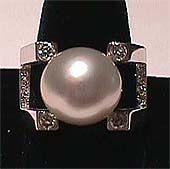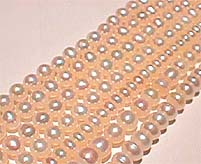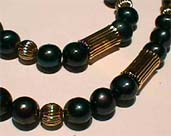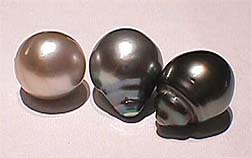Cultured Pearl

Cultured Pearl
Consumer Information
What color is it?: Take your pick. Today pearls are being cultured in virtually every color of the rainbow.
What is the story behind this gemstone?: Pearls were first successfully cultured in Japan around 1921 by Mr. Kokichi Mikimoto. Before that time only natural pearls were available, and the prices were very high and supplies sporadic at best. Today, cultured pearls are available in virtually any size, shape, and color that you can imagine. There are akoya cultured pearls from Japan, freshwater cultured pearls most of which are coming out of China, and South Sea and Tahitian pearls coming from Tahiti and Australia that are shown below. The story of pearls is very long. And I strongly recommend consumers to find a qualified independent professional retail jeweler who sells a lot of different types of pearls in order to get the whole story…which we don’t have room for on this page.
Can I wear it everyday?: Yes. But be sure and wait to put your pearls on until after you put all that hair spray and perfume on. Hair spray and perfume are what causes pearls to turn off color. Sticks to the pearl and cannot be removed. So wear them everyday. But put them on as you walk out the door.
Is it expensive?: Very much yes…and very much no. Cultured pearls today range from very expensive for fine quality matched strands, to fairly cheap for the strands sold by the discount stores. Basically, with pearls as with anything else, you get what you pay for. And nobody sells nice quality pearls for cheap prices.
Is it a birthstone?: Yes, for June Brides….(wonder why?)

What do I need to know before going shopping?: Read this very carefully if you would please. Cultured pearls get to be of better quality the longer they stay in the oyster. The longer they stay, the thicker the nacre layer that the oyster puts on the pearl. The thicker the nacre layer, the more expensive the pearl. Now, it can be difficult for a consumer to tell just how thick a nacre layer is. Gemologist can tell because we can see down the drill hole and see how thick the nacre layer is. But you cannot. And here is the problem. A pearl that has not been in the oyster very long will be hard to identify from one that has been in for a long time, to the untrained eye. Which is how some of these discount stores can tell you that they are selling you a fine quality strand of cultured pearls for $600.00 that is equal to one being sold in your local retail jeweler for $2000.00. Problem is, what they are not telling you is that the $600.00 pearls have very thin layers of nacre, which means that after only a few months of wear you could end up with some white beads rather than cultured pearls. Because all the nacre will wear off. So if you want to purchase a nice strand of cultured pearls, stay with your local independent professional retail jeweler. And don’t believe the discount stores. Because the truth is…about two years ago a red tide killed off a great deal of the oyster beds in Japan. And there is a shortage of pearls right now. And nobody…and I mean nobody…is discounting pearls. Unless they are not telling you something. So stay with a properly trained gemologist with formal pearl training to get the right story.
Click here to visit….AProperPearl.com to learn more about pearl jewelry shopping.

General Information
Green/black cultured pearl necklace with 14kt. yellow gold accents.
Source: Japan, China, United States, Venezuela, and other markets
Chemical: Calcium carbonate in the form of aragonite layers
Formation: Various species of oyster
Crystal System: None
Unusual Properties: Orient

Gemological Information
Three South Sea Tahitian Pearls of creme, grey, and black colors. All measure approx. 13mm each.
RI: 1.530 – 1.685
Birefringence: .155
Optic Character: Organic
Specific Gravity: 2.70 + –
Hardness: 3-4
Transparency: Opaque
Special Identifying Properties and Tests: The old “tooth rub” where you rub the pearl on the lower cutting edge of your tooth. A scratchy or gritty feeling will generally indicate a cultured or natural pearl. Just be sure and brush your teeth if you are doing this test in front of a customer.
Synthetics: None
Imitations: Many and varied

